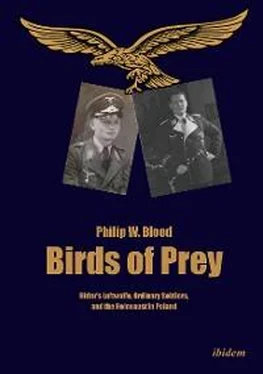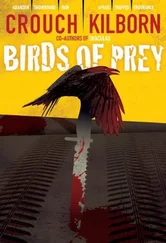The Luftwaffe’s participation in Bandenbekämpfung was critical to security operations on the Eastern Front. In April 1942, the Luftwaffe committed ground forces and support units. At that stage, German security and counterinsurgency still conformed to the army’s regulations and tactical doctrines. From August, the SS became the guardians of Bandenbekämpfung dogma within all the Third Reich’s civil-military authorities, while the Wehrmacht gradually filtered the terminology into reports. On 31 December, the Luftwaffen Kommando Ost issued a report on the entire period since April. The report opened:
The increasing activities of the bandits since 1941/42 in the rear of Army Group Centre, presents a serious danger to the supply and the conduct of the war by the army and air force, or exploit or colonize local economies. Although large-scale operations and smaller actions to combat the bandits were conducted successfully by the security units, the bandit activity increased, especially in the frontline or area of the frontlines. This was aggravated by Red Army Frontlaufer, or stragglers, often supplied by the Red Air Force, and the bands’ press-ganged local people and trained them. 6
The Soviets had organised raiding parties or bands of 200–400 men with specialists—scouts, messengers and saboteurs. These bands had constant and reliable communications with the Soviet Union, through signals, messengers and aircraft, which enabled re-supplies and reinforcements. These Red Army bands were properly organised and well armed, and ranged deep into occupied territory. 7The local populations were either directly assisting them or supplying food. The Germans were also disturbed that the band’s weapons were good quality and included mortars, anti-tank guns, and field artillery, and warned against underestimating the ‘bandits’. 8
In response to the partisan threat the Luftwaffe had been forced to take ‘special measures’ to protect the airfields. Luftwaffen Kommando Ost recognised that the few security troops could not stem the advance of the bands. In response, on 24 April, Göring granted permission for the formation of Lw.Infantry Regiment Moskau from surplus manpower from tactical formations, building and construction units, as well as signallers and staff cadres. Training was shortened and the regiment was deployed in June. For a period, the regiment was the only available infantry in the entire area of Luftwaffen Kommando Ost and were committed to security tasks in sectors with high concentrations of partisan infiltrations. They were also briefly engaged in the frontline when circumstances demanded their commitment to conventional warfare. The ‘bandits’, according to the Luftwaffe’s colourful use of the emerging Lingua Franca, were committed to widespread Bandenanschlägen (acts of terror), with attacks on railways roads, stores, bridges, dairies, landed estates, warehouses, and kidnapping mayors (collaborators). The insurgency increased into Autumn 1942, which led the Germans to take more radical measures. The bands posed a serious threat to the occupation, the supply of the front and military communications. The Luftwaffe had facilitated a general replenishment of all its units, with increased training and reinforcements. The only limitations to the increases were inadequate shelters for the troops with the onset of winter. The army and Luftwaffe imposed similar mission targets of Befriedungsräume (entirely pacified area)—achieved through pacification, cleansing, and destruction. The Luftwaffen Kommando Ost report included a Butcher’s Bill: body counts with destroyed villages and lists of captured booty. The list of destruction included: 19 ‘bandit-camps’, 88 enemy villages, 140 bunkers destroyed, 1,284 partisans shot after capture, and lists of equipment. Subsequent research by James Corum uncovered the Lw. Infantry Regiment Moskau was responsible for the destruction of 5,000 houses and killed seventy-six hostages. 9

Map 1: Poland divided, Nazi occupation zones in Poland, Soviet Russia and the Ukraine.
© J. Noakes & G.Pridham, Nazism 1919–1945 Volume 3, Foreign Policy, War and Racial Extermination , A Documentary Reader, University of Exeter Press, Exeter 1995, p. 1222, courtesy Liverpool University Press.
The report closed with a series of post-operational observations, which indicate that Göring’s lieutenants were not only experts in the application of security warfare, but were well versed in the politics of Bandenbekämpfung. The first observation concerned the local population vis-à-vis the Bandenlage (bandit situation): if the locals were peaceful, they were usually ‘happy’ to be protected by German troops; in bandenbeherrschten Gebieten (bandit-controlled areas) the locals work for the ‘bandits’; however, in the bandenverseuchten Gebieten (‘bandit’ diseased areas) the locals expected to be targeted by both sides. One comment concluded that local co-operation was necessary for the successful pacification and exploitation of an area, and it was therefore, critical to impose German rule. A second observation concerned the compromise of Nazi propaganda by security operations. It was recognised that burning villages for revenge or retribution might backfire, especially if the locals were both harmless and helpless. However, if an area was collaborating with the ‘bandits’ it was necessary to ‘cleanse with a firm hand.’ The third observation noted how the morale of the troops suffered when expected to combat the ‘bandits’ with inferior weapons. The bands were well supplied with superior and heavy weapons, and several times Luftwaffe flak artillery engaged in direct firing against heavily armed ‘bandits’. Another point mentioned the high level of mobility adopted by the ‘bandits’, which meant the Luftwaffe depended on the army’s security units to effect a mobile counter-strategy. A further observation criticised the absence of a unified command, and there had been reports of chaotic incidents. This had led to a centralisation of all Luftwaffe forces and the reorganisation of command structures. There had also been an introduction of strongpoints at important hubs along the railway lines, with Luftwaffe troops assigned to guarding junctions. A final point noted how the ‘bandits’ adopted ‘sneaky’ tactics, which required strong forces to counter and eradicate them. There was a palpable reluctance in a recommendation to conduct night-time actions and the troops to be trained to work in ‘night and fog’—the distasteful notion of resorting to ‘bandit’ tactics to counter the ‘bandits’. Operational training was acknowledged as the key to success and especially in learning to exploit the same methods as the ‘bandits’—the use of cunning, and ruthlessness. 10
1Adolf Galland, ‘Oberst Galland’, Wild und Hund, No. 47, 1941–42, pp. 357–358.
2See Chris Bellamy, Absolute War: Soviet Russia in the Second World War, (London, 2007) and Evan Mawdsley, Thunder in the East: The Nazi-Soviet War 1941–1945, (London, 2016).
3Helmut Heiber, David M. Glantz (ed), Hitler and his Generals: Military Conferences 1942–1945, (New York, 2002) pp. 14–17.
4NARA, T175/140/2668141-355, Weisung Nr. 46: Richtlinien für die verstärkte Bekämpfung des Bandenunwesens im Osten, Der Führer, OKW/WFSt/Op. Nr. 002821/42g.K., Führerhauptquartier, 18 August 1942.
5Philip W. Blood, Hitler’s Bandit Hunters: The SS and the Nazi Occupation of Europe, (Virginia, 2006), pp. 3–28.
6TsAMO 500-12454-623, Bericht über die Bandenbekämpfung durch Einheiten der Luftwaffe im Bereich des Lw.Kdo.Ost von 10.4. bis 31.12.42, 8 Jan. 1943.
Читать дальше













